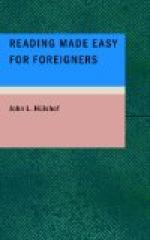The best time for sleep is during the silence and darkness of night. People who have to work nights, and to sleep during the day, have a strained and wearied look.
The amount of sleep needed depends upon the temperament of each individual. Some require little sleep, while others need a great deal.
Eight hours of sleep for an adult, and from ten to twelve hours for children and old people is about the average amount required.
Some of the greatest men in history are known to have been light sleepers. Most of the world’s great workers took a goodly amount of sleep, however. Sir Walter Scott, the great writer, took eight hours of sleep, and so did the famous philosopher Emanuel Kant. Children need more sleep than grown people. They should retire early and sleep until they awake in the morning.
When fairly awake we should get up. Dozing is unhealthful, especially for young people.
“Early to bed and early to rise,
Makes a man healthy, wealthy and wise.”
LESSON XXVI
CURIOUS BIRDS’ NESTS
Among the most curious nests are those made by the birds called weavers. These feathered workmen serve no apprenticeship; their trade comes to them by nature; and how well they work at it! But then you must admit that Nature is a skillful teacher and birds are apt scholars.
The Baltimore oriole is a weaver, and it makes its nest out of bark, fine grass, moss, and wool, strengthening it, when circumstances permit, with pieces of string or horse-hair. This nest, pouch-shaped, and open at the top, is fastened to the branch of a tree, and sometimes is interwoven with the twigs of a waving bough. The threads of grass and long fibers of moss are woven together, in and out, as if by machinery; and it seems hard to believe that the little birds can do such work without help.
The tailor-bird of India makes a still more curious nest: it actually sews, using its long, slender bill as a needle. Birds that fly, birds that run, birds that swim, and birds that sing are by no means rare; but birds that sew, seem like the wonderful birds in the fairy-tales. Yet they really exist, and make their odd nests with great care and skill. They pick out a leaf large enough for their nest, and pierce rows of holes along the edges with their sharp bill; then, with the fibers of a plant or long threads of grass, they sew the leaf up into a bag. Sometimes it is necessary to sew two leaves together, that the space within may be large enough.
This kind of sewing resembles shoemakers’ or saddlers’ work; but, the leaf being like fine cloth and not like leather, perhaps the name “tailor-bird” is the most appropriate for the little worker. The bag is lined with soft, downy material, and in this the tiny eggs are laid—tiny indeed, for the tailor-bird is no larger than the hummingbird. The weight of the little creature does not even draw down the nest, and the leaf in which the eggs or young birds are hidden looks like the other leaves on the trees; so that there is nothing to attract the attention of the forest robbers.




